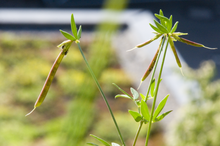Common horn clover
| Common horn clover | ||||||||||||
|---|---|---|---|---|---|---|---|---|---|---|---|---|

Common horn clover ( Lotus corniculatus ) |
||||||||||||
| Systematics | ||||||||||||
|
||||||||||||
| Scientific name | ||||||||||||
| Lotus corniculatus | ||||||||||||
| L. |
The common horn clover ( Lotus corniculatus ), also called common horn clover and also called Schotenklee in Switzerland , belongs to the genus horn clover ( lotus ).
Plant description
The herbaceous plant reaches heights of between 5 and 30 cm. The stipules are oblique-egg-shaped, pointed and almost as large as the leaves . The leaves are obovate to wedge-shaped. The underside of the leaf is bluish green.
The golden inflorescences are two- to seven-flowered and have three small bracts at the base. The calyx teeth are inclined before flowering. The 15 mm long yellow corolla is often reddish on the outside. The shuttle is bent up at right angles towards the tip. A special pump mechanism is used to pollinate the flowers. The pollen is emptied in the bud state. The club-shaped swollen filaments form a piston that presses the pollen out of the flower if the boat and wings are burdened by an insect. Flowering time is from May to September.
The crooked legume gave the species its name.
The common horn clover is a fairly variable species and mostly tetraploid . The chromosome number is 2n = 24.
ecology
Common horn clover is also used as a forage crop, nitrogen supplier and bee pasture . Its nectar contains an average of 40% sugar , and every single flower produces 0.08 mg of sugar a day. In addition, the common horn clover is an important food source for the blue grouse .
The common horn clover has roots up to a meter deep. Common horn clover is attacked by the rust fungus Uromyces euphorbiae-corniculati with uredia and telia .
toxicology
The plant contains cyanogenic compounds that split off hydrogen cyanide. The amounts usually present are harmless to mammals , but in snails , the main enemies of the freshly sprouting horn clover, they act as a food poison.
Occurrence
The main distribution area of this species is the middle and western Eurasia and the northern Mediterranean area . In Austria it is very common in all federal states.
The species prefers meadows, grassy fields, semi- arid grass , bushes, quarries , rocks and roadsides as a location . It thrives on warm, moderately dry to fresh, nutrient-rich and base-rich, more or less humus-rich, loose loam soils. It occurs in societies of the order Arrhenatheretalia, but also in the associations Mesobromion or Molinion. In the Alps it can be found at altitudes of around 2300 m. In the Allgäu Alps, it rises on the Kemptener Köpfle in Bavaria to an altitude of 2150 meters.
photos
Inflorescence of common horn clover ( Lotus corniculatus ):
literature
- Gunter Steinbach (Ed.), Bruno P. Kremer u. a .: wildflowers. Recognize & determine. Mosaik, Munich 2001, ISBN 3-576-11456-4 .
- Manfred A. Fischer , Wolfgang Adler, Karl Oswald: Excursion flora for Austria, Liechtenstein and South Tyrol. 2nd, improved and enlarged edition. State of Upper Austria, Biology Center of the Upper Austrian State Museums, Linz 2005, ISBN 3-85474-140-5 .
- Ruprecht Düll , Herfried Kutzelnigg : Pocket dictionary of plants in Germany and neighboring countries. The most common Central European species in portrait. 7th, corrected and enlarged edition. Quelle & Meyer, Wiebelsheim 2011, ISBN 978-3-494-01424-1 .
Individual evidence
- ↑ a b c Erich Oberdorfer : Plant-sociological excursion flora for Germany and neighboring areas . 8th edition. Verlag Eugen Ulmer, Stuttgart 2001, ISBN 3-8001-3131-5 . Page 598-599.
- ↑ Helmut Horn, Cord Lüllmann: Das große Honigbuch , Kosmos, Stuttgart 3rd edition 2006, ISBN 3-440-10838-4 , p. 30.
- ↑ Peter Zwetko: The rust mushrooms Austria. (PDF), Supplement and host-parasite directory for the 2nd edition of the Catalogus Florae Austriae, III. Part, Book 1, Uredinales. (PDF; 1.8 MB).
- ↑ Erhard Dörr, Wolfgang Lippert : Flora of the Allgäu and its surroundings. Volume 2, IHW, Eching 2004, ISBN 3-930167-61-1 , p. 138.
Web links
- Common horn clover. In: FloraWeb.de.
- Common horn clover . In: BiolFlor, the database of biological-ecological characteristics of the flora of Germany.
- Profile and distribution map for Bavaria . In: Botanical Information Hub of Bavaria .
- Lotus corniculatus aggr. In: Info Flora , the national data and information center for Swiss flora . Retrieved November 18, 2015.
- Distribution in the northern hemisphere according to Eric Hultén
- Thomas Meyer: Data sheet with identification key and photos at Flora-de: Flora von Deutschland (old name of the website: Flowers in Swabia )







